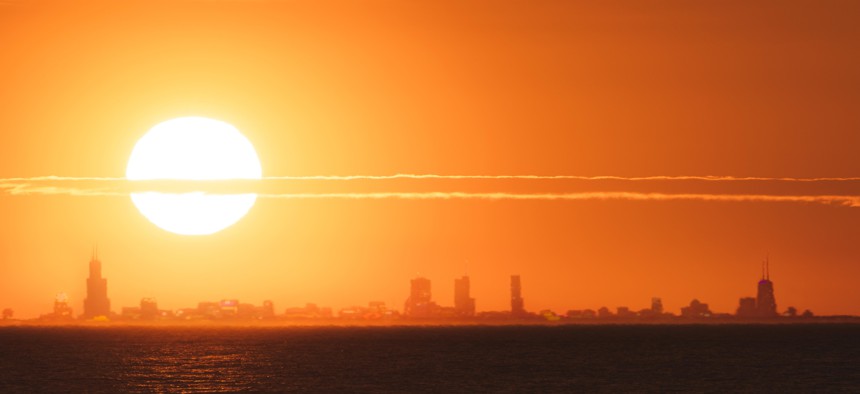How Cities are Trying to Combat the Nation's Deadliest Weather Risk

The sun sets behind Chicago's skyline as seen from Indiana Dunes State Park in Chesterton, Indiana. John Crouch
Heat doesn’t get the same attention as hurricanes or wildfires, but city officials are paying more attention to it as hot temperatures become more common.
Heat has long been the deadliest weather phenomenon in the United States. But local officials are keying in on the risks it poses, after heat-related deaths broke records from Arizona to the Pacific Northwest in recent years and as climate change threatens to make summer heat even more deadly.
Miami-Dade County, Florida hired a chief heat officer; Phoenix and Los Angeles quickly followed suit. While local officials have previously contemplated how to improve the resilience of their communities to environmental and other external threats, they’re now also meeting to exclusively discuss excess heat.
Ladd Keith, an assistant professor of planning at the University of Arizona, said cities and other local governments are starting to figure out ways to cut down on the dangers of high heat. But many people in government, and in society at large, forget about the threat until temperatures start to climb.
“There’s a challenge. Even though it’s the No. 1 weather-related killer, heat is invisible. It doesn’t impact property the same way [as hurricanes or other deadly storms]. It tends to impact marginalized and low-income folks the most,” Ladd said. “So we’re not at the same level of planning as we are for heat compared to other hazards like wildfires, flooding, tornadoes and things like that.”
Ladd and Sara Meerow, an Arizona State University professor, released a guidebook for local planners on how to cope with heat-related problems. The 101-page text, published by the American Planning Association, covers many of the ways the built environment can affect how residents experience hot weather.
One of the overarching themes is that residents of poorer areas suffer more from heat-related problems, because of the ways their neighborhoods are designed, built and used.
The temperature in some urban areas can be 7.2 degrees Fahrenheit hotter during summer days than in nearby areas, because of the “heat island” effect. Streets, buildings and other impervious surfaces absorb heat, rather than reflecting it back to the sky.
The phenomenon is especially noticeable in low-income areas, where trees and plants are less common and more of the ground is paved. Plus, some people in lower-income areas, like those without homes, spend more time outside.
One study of metro areas in the Southwest found that areas that are home to the poorest 10% of residents were 4 degrees hotter, on average, than the wealthiest neighborhoods of the same area, Ladd and Meerow noted in their text.
Even though local officials confront many of the same problems, their slate of solutions may vary considerably from one place to another, Ladd said in an interview.
For example, one of the most popular options offered by cities is to plant more trees to cool streets, sidewalks and bike paths when temperatures spike. But that broad-based approach is not always practical in the West, which is experiencing a major drought, he said.
“We have the ability to plant more trees in strategic locations like cooling corridors that serve a lot of different functions,” he said. Cities can use green infrastructure, like rain gardens, to capture stormwater when it does rain. But when it comes to addressing the “heat crisis,” he added, planting trees alone won’t be enough.
Cities can build man-made shade structures to help, but the problem requires planners to think beyond just physical infrastructure, Ladd said. That means making sure that people have affordable housing or air-conditioned spaces they can visit during the day. Emergency workers need to reach out to people without homes before extreme heat hits.
A heat wave in the Pacific Northwest last year set records for weather-related deaths. One reason it was so devastating was that, compared to the rest of the United States, relatively few homes in that region have air conditioning. More than 90% of U.S. homes have air conditioning, but only 78% of homes in Portland, Oregon and 44% of those in Seattle do.
But more households in the region started installing climate control even before last year’s heat, Ladd said. Many of them were simply looking for a way to keep smoke from nearby wildfires from getting into their homes.
Still, just putting in more air conditioners won’t be enough either, Ladd stressed, because many residents can’t afford to keep them running. That’s why social programs like the Low Income Home Energy Assistance Program, a federal fund that also helps residents pay for winter heating bills, are important, as well as city-led efforts to open cooling centers.
Miami-Dade County, for example, is working on opening “resilience hubs” that will give residents a cool place to stay, food and water, internet access and other amenities during heat emergencies or other crises, Ladd said.
Meanwhile, rising temperatures can complicate plans to reduce the carbon pollution that is causing the warming in the first place. Rising heat makes activities like walking and biking less pleasant – and sometimes more dangerous – which encourages people to instead get into their cars to make trips.
“Mixed-use and walkable urban spaces could also become less attractive unless properly shaded and designed with heat mitigation in mind,” Ladd and Meerow wrote.
“If we don’t get control over how we’re planning and designing cities … it’s going to be a hard sell to get people out of their cars to walk more, to bicycle more and to do more active transportation,” Ladd said.
“I think we can achieve all of those things, but we have to think holistically and go after them all at the same time in the built environment,” he said.
Daniel C. Vock is a senior reporter for Route Fifty based in Washington, D.C.
NEXT STORY: Federal Covid Aid is Funding a Pickleball Court Construction Boom






